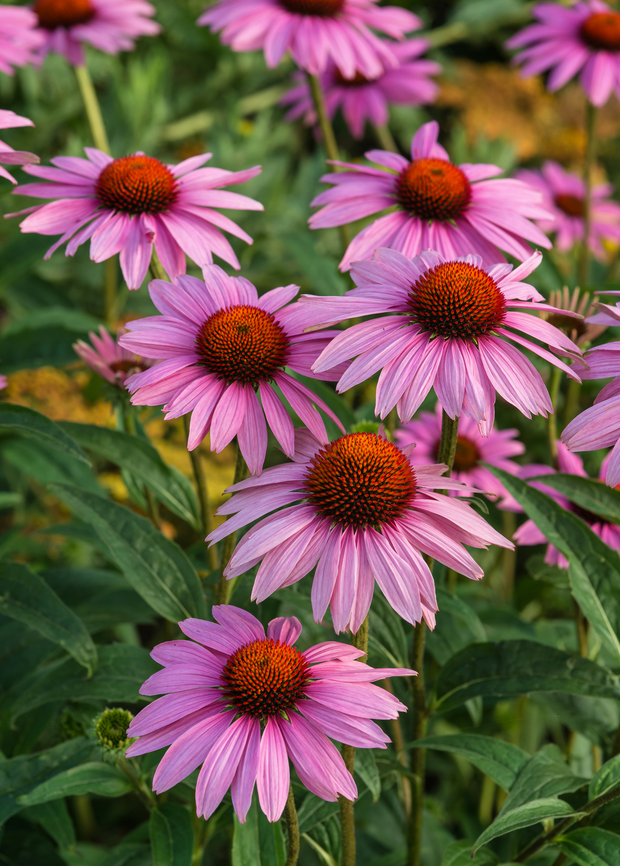

You’ll also want to harvest it when the flower is still young - usually when the pistils of the center are still in that light-green stage and the petals haven’t fully unfurled as of yet. If it holds pretty firm, then it’s ready to cut). If the flower flops back and forth like one of those giant inflatable flappy characters you see outside of a car dealership, it’s not ready. If you’re using it in the flowering stage, you’ll want to pick when the stem is firm (grab the stem and wiggle it. Either one is a great floral material, but it will determine your time of harvest depending on which stage you want to use it in. When you’re harvesting echinacea, you need to decide if you’re going to use the actual flower itself or the seedhead. They will form a rosette of glossy, broadleaf foliage first, then will go onto send up their flower stalks later.
#PURPLE CONEFLOWER GARDEN FULL#
Note that we can have our echinacea flowering the first year from seed (by August usually) if we start them early enough, but most people will require at least one full growing season before seeing them flower, especially if you have a short growing season. When planting out echinacea, ensure they get a good deep watering to help them establish well, and then water them every day for a week to ensure that their root ball stays moist and can start growing into the surrounding soil.

They’re very hardy and vigorous plants, so even if they get a bit rootbound in the container they still will do just fine, establishing very readily. We transplant them out once they are hardened off and have their first set of leaves. The main issue will be drainage - echinacea may not survive in areas where their roots are constantly being flooded by water, so be sure to plant them where they will stay moist during the summer and a bit drier during the winter.

Cultivating EchinaceaĮchinacea will do well in just about any soil - they will even thrive in hard-packed clay (which most would not do well in) without any issue, so finding a site for them isn’t too hard. If you have varieties that are a little bit harder to start from seed - such as the ‘Cheyenne Spirit’ that are a bit slower and less uniform - you can start them off in a moist coffee filter or paper towel and then transplant them out as the seeds start germinating. You can prick and plant them out as single plants, but I find that they’re much more impressive as a clump, and they do a much better job suppressing weeds together (with no issues of crowding multiple plants in a small space). We sow ours into 72 cell trays to allow them to form a healthy root system, sowing multiple seeds per cell to create more of a “clump” than single plants. They grow very readily and quickly - usually sprouting in about a week or so - and germinate readily when kept on a heat mat OR at least at with a soil temperature of 75-85 F. Growing Echinacea from Seedĭespite being a native perennial, echinacea is one of the few North American native perennials that doesn’t require a period of cold stratification - where you keep the seed moist and cold for a set period of time. Still, they are cool enough to bother with and if reliably perennial are better than attempting to grow scabiosa-flowering zinnias (which look similar but hardly ever grow reliably that way from seed). Note that the cultivared varieties of echinacea are on a whole notoriously less vigorous and weaker than their wild-type counterparts - they have a lot of issues overwintering as a perennial in most cases, and even when they do overwinter they are much smaller and grow much more slowly. Many of these are particularly well-suited for use in wedding design given their more muted colorations.īut even more fun are the scabiosa-type echinaceas that have a large poofball of petals on top of their cone, forming a tightly-packed mound of florets that remind me of a double gerbera daisy or an anemone-form dahlia - and are absolutely a delight in arrangements.

We are particular fans of the ‘Cheyenne Spirit’ varieties that have the same shape and form as the regular Echinacea purpurea but come in a variety of colors - reds, oranges, cremes, primrose yellows and white that are a wonderful change from the pale pink and purple of the regular variety. However if you like your flowers big and fluffy (or grossly overbred and mutated as one of my friends would say) there are also a lot of fancifully formed echinacea out there. There’s even a yellow echinacea, Echinacea paradoxa that has bright black-eyed-susan-yellow petals with the distinct bristly head of the Echinacea family.


 0 kommentar(er)
0 kommentar(er)
